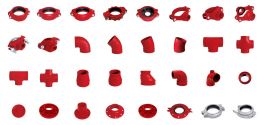Grooved Fittings and Mechanical Couplings

Grooved fittings and mechanical couplings are two types of piping components used in a wide range of industrial applications. Both offer significant advantages over traditional welded piping systems, including faster installation, easier maintenance, and improved flexibility. In this article, we'll take a closer look at what grooved fittings and mechanical couplings are, how they work, and some of their key benefits.
What are Grooved Fittings?
Grooved fittings are a type of piping component used to connect two or more pipes together. They are made up of two main parts: a grooved pipe end and a coupling that fits over the end. The grooves on the pipe end are designed to be compatible with the teeth on the coupling, creating a secure and leak-free connection.
The process of grooving involves cutting a groove into the end of the pipe using a specialized machine. The groove is typically a semi-circular shape that runs around the circumference of the pipe, with a depth and width that is specific to the size of the pipe and the type of coupling being used.
Grooved fittings are typically made from ductile iron, although other materials such as stainless steel, copper, and PVC can also be used. They are available in a wide range of sizes and configurations to accommodate different piping systems, and can be used for both aboveground and underground applications.
What are Mechanical Couplings?
Mechanical couplings are a type of fitting used to connect two pipes together. Unlike traditional welded connections, which require skilled labor and specialized equipment to install, mechanical couplings can be easily installed using basic tools and minimal training.
Mechanical couplings work by clamping onto the outside of the pipe ends, creating a secure and leak-free connection. They typically consist of two halves, each with a series of teeth or gripping elements that mesh together when the halves are tightened. This creates a strong mechanical bond that holds the pipes firmly in place.
Like grooved fittings, mechanical couplings are available in a wide range of sizes and configurations to accommodate different piping systems. They can be made from a variety of materials, including ductile iron, stainless steel, and plastic.
Benefits of Grooved Fittings and Mechanical Couplings
Both grooved fittings and mechanical couplings offer a number of significant advantages over traditional welded piping systems. Some of the key benefits include:
- Faster Installation: Grooved fittings and mechanical couplings can be installed up to five times faster than traditional welded connections, reducing installation time and labor costs.
- Easier Maintenance: Because grooved fittings and mechanical couplings can be easily disassembled, they make maintenance and repair work quicker and easier.
- Improved Flexibility: Grooved fittings and mechanical couplings are designed to allow for some movement and flexibility within the piping system, reducing stress and preventing damage caused by thermal expansion and contraction.
- Increased Safety: Grooved fittings and mechanical couplings create a secure and leak-free connection that helps prevent accidents and injuries caused by leaks or ruptures in the piping system.
- Lower Costs: The faster installation times and reduced labor costs associated with grooved fittings and mechanical couplings can help lower overall project costs.
Applications of Grooved Fittings and Mechanical Couplings
Grooved fittings and mechanical couplings are used in a wide range of industrial applications, including:
- HVAC systems: Grooved fittings and mechanical couplings are commonly used in heating, ventilation, and air conditioning (HVAC) systems for both commercial and residential buildings.
- Fire protection systems: Grooved fittings and mechanical couplings are used extensively in fire protection systems for their speed of installation, flexibility, and safety benefits.
- Industrial piping systems: Grooved fittings and mechanical couplings are used in a wide range of industrial piping systems, including water treatment plants, chemical processing plants, and power generation facilities.
- Mining: Grooved fittings and mechanical couplings are used in the mining industry for piping systems that transport water, slurry, and other fluids.
- Oil and gas: Grooved fittings and mechanical couplings are used in the oil and gas industry for both upstream and downstream applications.
- Marine: Grooved fittings and mechanical couplings are used extensively in the marine industry for piping systems on ships and offshore platforms.
- Food and beverage: Grooved fittings and mechanical couplings are used in the food and beverage industry for piping systems that transport water, liquid food products, and other fluids.
- Pharmaceuticals: Grooved fittings and mechanical couplings are used in the pharmaceutical industry for piping systems that transport liquids and gases used in the production of pharmaceuticals.
Overall, grooved fittings and mechanical couplings offer numerous benefits, including faster installation, easier maintenance, improved flexibility, increased safety, and lower costs.




















